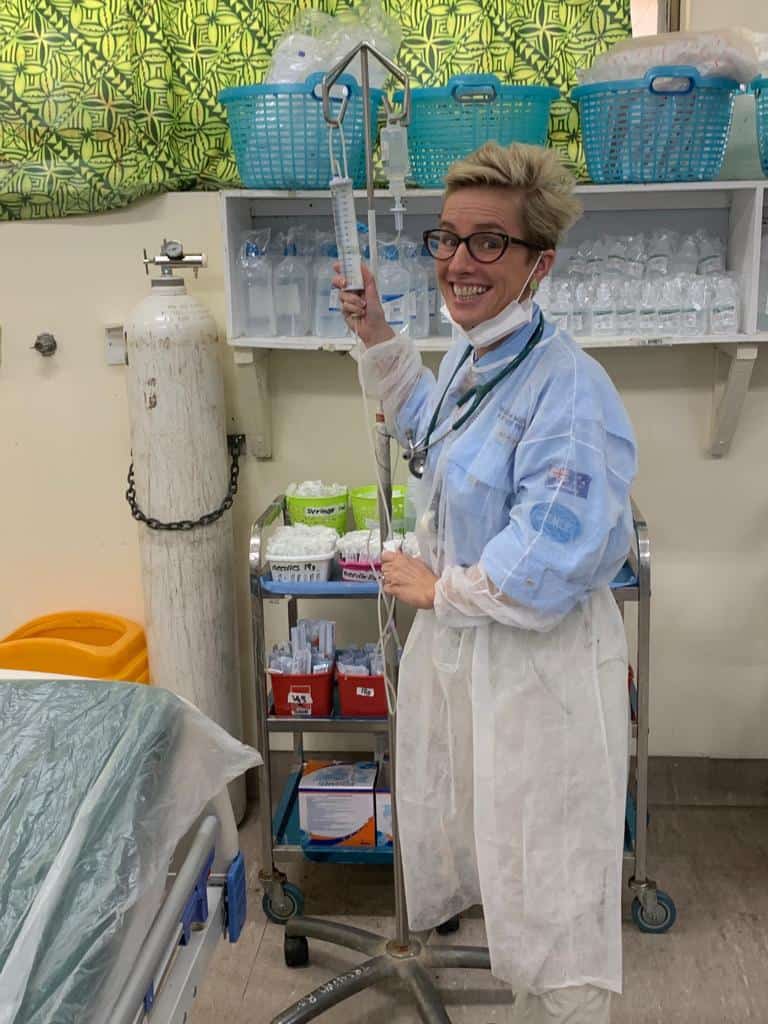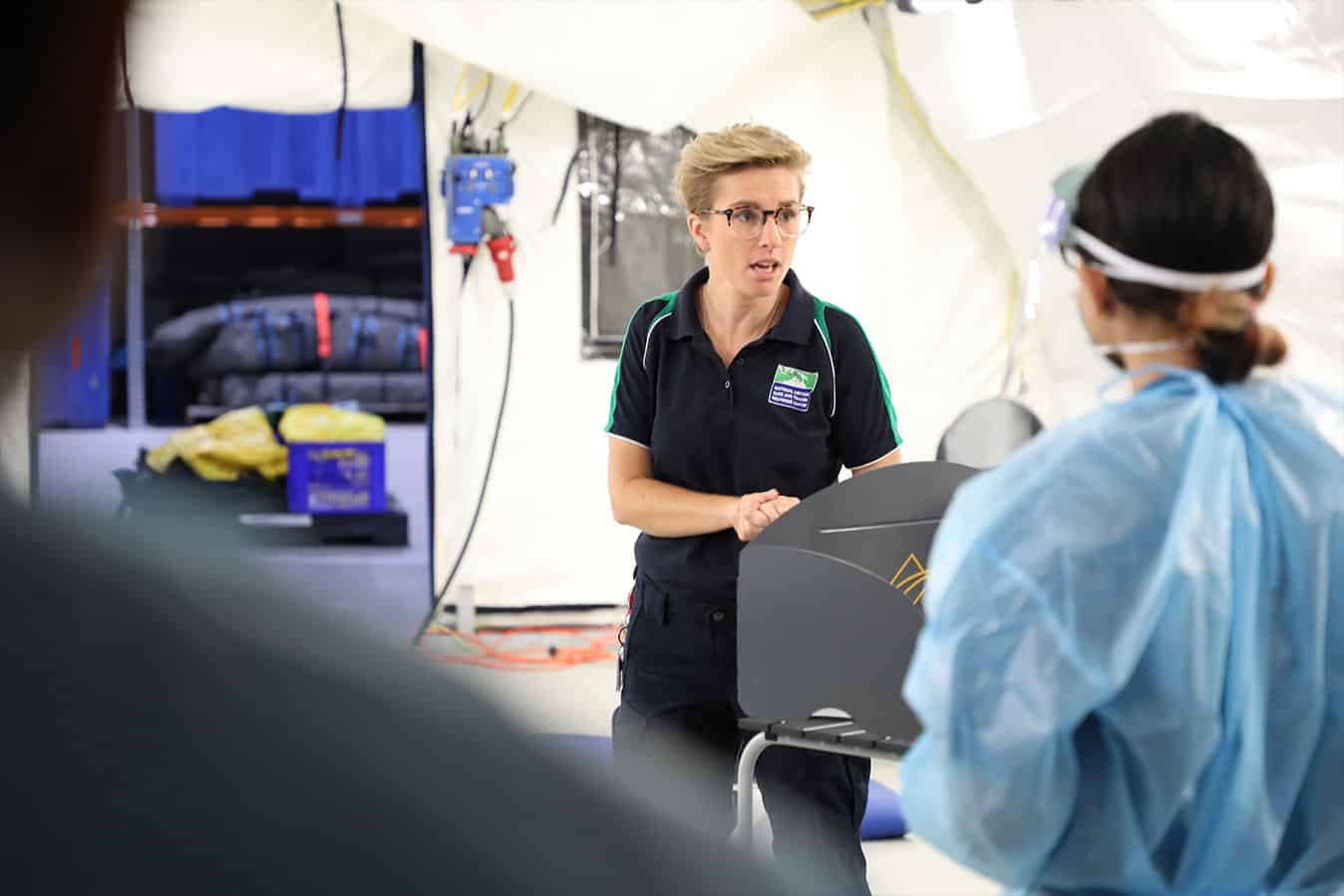A Clinical Nurse Consultant with the National Critical Care and Trauma Response Centre (NCCTRC), based at the Royal Darwin Hospital, Emily McGrath works within a multidisciplinary team providing care to people who have been involved in serious accidents and potentially suffered critical injuries triggered by trauma.
But on any given day at short notice, she is primed to answer the call-up from Australian Medical Assistance Teams (AUSMAT), a specialist medical response team of nurses, doctors and paramedics that rapidly deploy to emergencies or disaster zones to deliver clinical care and health support.
Established following the 2002 Bali bombings, the Australian government has deployed AUSMAT to humanitarian disasters including Typhoon Haiyan, which hit the Philippines in 2013, Papua New Guinea’s Southern Highlands earthquake in 2018, and last year’s measles outbreak in Samoa.
Most recently, AUSMAT sent teams to support Victoria’s COVID-19 crisis in aged care, where tragically, hundreds of resident have died.
Emily studied nursing at Charles Darwin University, where she developed a strong interest in Indigenous health.
When she began her career, a passion for social justice steered her towards nursing that provided care to Indigenous people, homeless refugees, and women and families experiencing domestic and family violence.
As well as working across the remote Northern Territory, she also tested her nursing abroad, including being part of a homeless team within inner-city London that ran health clinics in homeless shelters and hostels.
“I’ve always had an appreciation for human rights and justice and advocacy for vulnerable populations,” Emily says.
Emily had previously deployed to international disasters with humanitarian organisations such as MSF before teaming up with AUSMAT several years ago.

She says her involvement with global pandemics, disaster management and refugee management mirrored the goals and philosophies upheld by AUSMAT as they respond to emergencies.
AUSMAT members undertake additional training and education before deploying to international disaster zones and managing the health response.
A general course covers subjects such as the humanitarian space, disaster response and role of AUSMAT during deployments. Candidates are also exposed to the mental and physical challenges of deploying into disaster zones through field simulation where they must use equipment they will deploy with and plan and prepare as though it were a real event.
Successful candidates are registered on the NCCTRC database and undergo medical and fitness checks, ongoing training/exercises and foreign language classes.
“Compassion and empathy stand out to me,” says Emily when asked what key attributes nurses need to succeed with AUSMAT.
“It’s about being able to empathise with the community that you’re treating and having an understanding of their condition.”
Healthcare professionals in AUSMAT are often highly experienced and leaders in their disciplines.
For nurses looking to join, Emily suggests being multi-skilled and experienced across a variety of areas within the profession is valuable.
“Quite often when you deploy to emergencies, you’re tasked to carry out the skills that you’re usually trained in, but you also need to be multi-skilled and be able to adapt to different situations,” she says.
“As a nurse and midwife, I have the capability to be able to work in the emergency department (ED) but I also have the skills to be able to respond to obstetric emergencies and provide maternity care.”
Emily says a solid understanding of public health and epidemiology, the complexities of disaster management and awareness of the disparity in access to healthcare often faced by populations being treated is also useful.
AUSMAT members are essentially on-call to deploy to humanitarian disasters at any time.
Emily has been deployed twice, assisting during last year’s Samoan measles outbreak, and more recently putting her hand up to help Victoria’s COVID-19 aged care crisis in late July when the second wave of the pandemic gripped the state.
“I got asked on a Monday and I was ready to be deployed by the following morning,” Emily, who took on the responsibility of a Team Leader, recalls.
“There’s always that trepidation. Am I going to get it? How can I protect myself? How can I protect my team? When I’m responsible for the team, how can I make sure they do the right thing and that we look after each other so that none of us gets sick?”
In Victoria, Emily and her AUSMAT team were tasked with visiting aged care facilities identified as at risk or high risk of experiencing a COVID-19 outbreak.
At the time, the total number of active COVID-19 cases linked to aged care in the state was over 900.
“The initial visits were responding to facilities who had known outbreaks and part of our role was to assist the facilities to implement appropriate infection prevention strategies and put them into practice,” Emily says.
“We also assisted in leadership and coordination within the facilities so that they were able to respond more efficiently and effectively. Sometimes we were going into facilities where 100% of their staff had been furloughed and agency staff filled the void. We had to consider how they could do the best job possible without knowing the residents, without having any background understanding of the facility itself, and putting strategies in place to keep staff safe.”
Emily suggests the aged care workforce, which is broadly undervalued and underpaid, and often involves staff working across multiple sites, likely doesn’t have the required knowledge of infection control practices.
Thus, a crucial part of the AUSMAT team’s focus was implementing simple strategies to make infection control practices easier to navigate.
“Some of the strategies we implemented were as simple as designing appropriate signage for donning and doffing and setting up appropriate areas to safely don and doff.”
Emily believes progress was made during the three-week deployment, with the team shifting from typically visiting high-risk facilities with outbreaks to implementing infection prevention practices at facilities with no cases and not in outbreak mode.
Like any deployment, Emily says Victoria’s COVID-19 aged care battle reinforced the importance of good leadership, coordination and management in the face of health crises.
“Aged care is such a complex area,” she says.
“There’s different funding models. You have multiple stakeholders involved, private enterprises and private organisations running the majority of facilities. So the coordination between state and national governments, as well as those on the ground private facilities, is quite complex.”
“When we’re going into the actual facilities, we’re going into people’s homes. This is not an acute care setting. We are going into people’s homes and trying to put acute care principles into a home care setting and that is really difficult to do. The needs of the residents are really complex and involve managing not only their physical and psychological needs but their emotional and social wellbeing. If you don’t get that in harmony, if you don’t provide holistic care and one of those elements is compromised, then the whole person is compromised and they are at risk of deteriorating dramatically.”
Emily says one of the more uplifting moments of the challenging deployment was receiving news from a facility that they were able to emerge out of outbreak management mode and how thankful their staff were of the interventions the AUSMAT team were able to put in place.
“They were able to let their residents walk around the facility, just simple things like that. The residents were able to come out of their rooms and although they had masks on, they were able to interact with other residents. That contact was really wonderful to hear.”
In a similar vein, Emily says the commitment and dedication of aged care staff stood out most during the deployment.
“My lasting memory is how the core staff who would normally work at these residential aged care facilities, how much they care for their residents and how much effort they put in to caring for those residents and making their lives more worthwhile and enjoyable.”
On a personal level, Emily feels honoured to have played a role in Australia’s COVID-19 pandemic response.
“Many of our nursing and support staff in the aged care facilities were being furloughed either because they were unwell or they had been in close contact with a case and had to isolate,” she says.

“These people knew these residents better than anybody else, so for us to go in there to be able to support them to do the work that they can do best, so they can come back to work, I felt very honoured to be able to contribute.”
Upon her return to Darwin, Emily was recruited to a new project with the NCCTRC focusing on the local aged care response to COVID-19 in the Northern Territory.
Sharing the lessons she learned from the COVID-19 aged care response in Victoria, Emily’s role will provide infection prevention and control expertise within the aged care sector in the NT and is aimed at ensuring appropriate outbreak guidelines are implemented to stop potential outbreaks.
Emily says her association with AUSMAT opened up a whole new world of possibilities when it came to her nursing career.
“The best part is the variety. Being able to go into places that we would invariably never be able to go to. To be able to contribute to your international nursing and midwifery colleagues and support them. To work side by side with staff from a host nation. It’s a real privilege to work with people from backgrounds other than our own to see how they do it.”
Her main advice to nurses considering joining the team is to gain as much experience as possible across diverse areas.
“If you’re a midwife, then get experience in all areas of midwifery, from the antenatal delivery suite to post-natal, that’s really important. Also try to extend your skills into other areas. If you’re an emergency nurse, try and get some experience in intensive care and also in primary healthcare. Take those opportunities where you can to get experience in other areas of your nursing practice.”
For more information on AUSMAT click here









One Response
I would like to apply for AUSMAT Nurse ..please advise what I need to do. Please advise.
Robin Tangeria